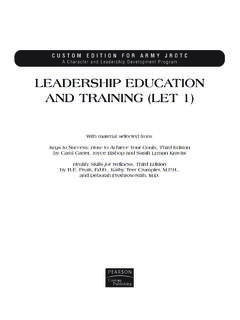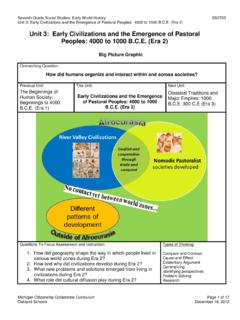Transcription of Unit 26: Film Studies - Mrs Robert's Site
1 unit 26: film Studies unit code: T/600/6634. QCF Level 3: BTEC National Credit value: 10. Guided learning hours: 60. Aim and purpose This unit aims to develop learners' understanding of how films are created for specific audiences and how they make meaning for those audiences through an exploration of industry practices and the application of a range of theoretical approaches. The insights which learners develop will inform their future production work. unit introduction All approaches to studying film are theoretical to a greater or lesser extent. Even casual discussion about movies often reveals a recognition of, and a cultural investment in, the auteur as the source of the film 's meaning. A theoretical approach to film simply recognises that we need to consciously apply specific ways of responding to film texts in order to make our interpretation clear, not only to others but to ourselves as well.
2 Done properly this is not merely an exercise in regurgitating theory: the effective application of theory and the use of specific analytical tools to produce different understandings of the same texts improves our understanding, enlivens our appreciation, and, for film practitioners, informs and enhances their production activity. Through following this unit learners will develop an understanding of a number of theoretical approaches to film and apply them to specific films. Learners will come to understand that films do not exist in a vacuum, nor do they simply appear like flowers in the spring. Rather, they are created by a range of determinants and influences which include, amongst others, the culture and politics of the country where they are produced, the finance that enables their production, the technology of film production, distribution and exhibition, and the nature and structure of the industry which produces them.
3 In addition, learners will explore the often complex relationship between audiences and films and will be able to understand why and how audiences watch and make sense of films in particular ways. There are opportunities in the unit to develop and apply research techniques through the completion of a piece of practical audience research. The unit will also help to put production work done in other units into context. Learning outcomes On completion of this unit a learner should: 1 Be able to apply different analytical approaches to films 2 Understand the relationship between films and their production contexts 3 Understand the relationship between producers and audiences 4 Understand the relationship between audiences and films. Edexcel BTEC Level 3 Nationals specification in Creative Media Production Issue 1 January 2010 Edexcel Limited 2009. 1. unit content 1 Be able to apply different analytical approaches to films Analytical approaches: methods, eg genre analysis, content analysis, narrative analysis, reception study, fan study; film theory, eg structuralism, semiotics, auteur theory, feminism, queer theory, Marxism, psychoanalytic Application: to extracts; to whole films; to genres 2 Understand the relationship between films and their production contexts Production contexts: Hollywood, Bollywood, British, developing countries, international co-productions, independent Factors influencing the relationship: financial determinants; funding bodies; quotas; tax incentives.
4 Technologies of production; distribution and exhibition; trends; genres and cycles; stars; social and political issues; regulatory issues; synergies between different films; vertical and horizontal integration 3 Understand the relationship between producers and audiences Relationship between producers and audiences: audience research; producer response to research;. audience targeting; distribution; publicity and marketing, eg advertising, reviewing, chat shows, product tie-ins, premieres, awards, on line presence 4 Understand the relationship between audiences and films Relationship between audiences and films: active spectatorship; pleasure; frameworks of interpretation;. media literacy; intertextuality; preferred readings; effects; fandom; interactivity; social networking; pre- and post-viewing experiences; conditions of reception, eg cinema, DVD release, online access Edexcel BTEC Level 3 Nationals specification in Creative Media Production 2 Issue 1 January 2010 Edexcel Limited 2009.
5 Assessment and grading criteria In order to pass this unit , the evidence that the learner presents for assessment needs to demonstrate that they can meet all the learning outcomes for the unit . The assessment criteria for a pass grade describe the level of achievement required to pass this unit . Assessment and grading criteria To achieve a pass grade the To achieve a merit grade the To achieve a distinction grade evidence must show that the evidence must show that, in the evidence must show that, learner is able to: addition to the pass criteria, in addition to the pass and the learner is able to: merit criteria, the learner is able to: P1 apply approaches to analysing M1 apply approaches to D1 apply approaches to analysing films with some appropriate analysing films coherently films critically, supporting use of subject terminology with reference to detailed points with arguments and [RL] illustrative examples and elucidated examples and generally correct use of consistently using subject subject terminology terminology correctly P2 describe the relationship M2 explain the relationship D2 comprehensively explain the between films and their between films and their relationship between films production contexts with production contexts with and their production contexts some appropriate use of reference to detailed with elucidated examples subject terminology illustrative examples and and consistently using subject [IE]
6 Generally correct use of terminology correctly subject terminology P3 describe the relationship M3 explain the relationship D3 comprehensively explain between producers and between producers and film the relationship between film audiences with some audiences with reference to producers and film audiences appropriate use of subject detailed illustrative examples with elucidated examples terminology and generally correct use of and consistently using subject subject terminology terminology correctly P4 describe the relationship M4 explain the relationship D4 comprehensively explain between audiences and films between audiences and films the relationship between with some appropriate use of with reference to detailed audiences and films with subject terminology. illustrative examples and elucidated examples and generally correct use of consistently using subject subject terminology. terminology correctly.
7 PLTS: This summary references where applicable, in the square brackets, the elements of the personal, learning and thinking skills applicable in the pass criteria. It identifies opportunities for learners to demonstrate effective application of the referenced elements of the skills. Key IE independent enquirers RL reflective learners SM self-managers CT creative thinkers TW team workers EP effective participators Edexcel BTEC Level 3 Nationals specification in Creative Media Production Issue 1 January 2010 Edexcel Limited 2009. 3. Essential guidance for tutors Delivery Developing an understanding of different analytical models may appear daunting at first, but an accessible starting point could be to contrast a genre-based approach with an auteur approach. The former provides insight through identifying recurrent, significant elements (for example, in narrative, setting, iconography and character).
8 The latter finds meaning through identifying the recognisable elements which signify the presence of a particular film artist'. Both require an awareness that audiences and producers use sets of codes and conventions in order to classify films. Practice should be provided through, for example, exercises in which statements are matched with particular theoretical models to facilitate understanding of a range of writing about film . Abundant viewing of films and extracts, both in and out of class, is essential. Learners will also require opportunities to discuss ways of reading' in order to demonstrate an awareness that any act of interpretation is dependent on some kind of theoretical foundation. Group work, presentations and producing visual material can all illustrate the various ways in which films are determined by, and respond to, their contexts of production. Examples might include the relationship between films and computer games, the agendas of film funding bodies, the rise and fall of particular film cycles and genres.
9 Learners might also explore the influence of digital technology on production and costs, distributors voluntarily cutting films to fit a particular BBFC certificate and the evolution of the studio system. Other relevant activities would include audience research, simulations and production activity to indicate understanding of genre conventions. Input from professionals working in film production, distribution or exhibition will be valuable for learners. Visits to film screenings and film festivals will also be beneficial as will contact with staff from agencies working to develop audiences for film in the UK. Access to production equipment will provide an opportunity to produce evidence in forms other than the written essay, whilst also making links with other units and areas of learners' competence. Outline learning plan The outline learning plan has been included in this unit as guidance and can be used in conjunction with the programme of suggested assignments.
10 The outline learning plan demonstrates one way of planning the teaching and assessment of this unit . Topics and suggested assignments and activities Introduction to unit and unit assessment. Introduction to the film industry with case study screenings of clips and whole films. Introduction to film theory with case study screenings of clips and whole films. Auteur theory case study of one director with screening of two films. Lecture sequence genre, audience and industry: ascribing films to genres: codes and conventions how audiences choose films the industry, genre and distribution screenings of three films with class discussion. Individual case Studies on genre and audience. Edexcel BTEC Level 3 Nationals specification in Creative Media Production 4 Issue 1 January 2010 Edexcel Limited 2009. Topics and suggested assignments and activities Assignment 1 Theory in Action Learners produce a talking heads' video for a website aimed at young people interested in film .







